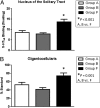Potential asphyxia and brainstem abnormalities in sudden and unexpected death in infants
- PMID: 24218471
- PMCID: PMC3838527
- DOI: 10.1542/peds.2013-0700
Potential asphyxia and brainstem abnormalities in sudden and unexpected death in infants
Abstract
Objective: Sudden and unexplained death is a leading cause of infant mortality. Certain characteristics of the sleep environment increase the risk for sleep-related sudden and unexplained infant death. These characteristics have the potential to generate asphyxial conditions. We tested the hypothesis that infants may be exposed to differing degrees of asphyxia in sleep environments, such that vulnerable infants with a severe underlying brainstem deficiency in serotonergic, γ-aminobutyric acid-ergic, or 14-3-3 transduction proteins succumb even without asphyxial triggers (e.g., supine), whereas infants with intermediate or borderline brainstem deficiencies require asphyxial stressors to precipitate death.
Methods: We classified cases of sudden infant death into categories relative to a "potential asphyxia" schema in a cohort autopsied at the San Diego County Medical Examiner's Office. Controls were infants who died with known causes of death established at autopsy. Analysis of covariance tested for differences between groups.
Results: Medullary neurochemical abnormalities were present in both infants dying suddenly in circumstances consistent with asphyxia and infants dying suddenly without obvious asphyxia-generating circumstances. There were no differences in the mean neurochemical measures between these 2 groups, although mean measures were both significantly lower (P < .05) than those of controls dying of known causes.
Conclusions: We found no direct relationship between the presence of potentially asphyxia conditions in the sleep environment and brainstem abnormalities in infants dying suddenly and unexpectedly. Brainstem abnormalities were associated with both asphyxia-generating and non-asphyxia generating conditions. Heeding safe sleep messages is essential for all infants, especially given our current inability to detect underlying vulnerabilities.
Keywords: 14-3-3 proteins; GABA receptors; bed-sharing; prone sleep; serotonin; sudden infant death syndrome.
Figures



References
-
- Heron M. Deaths: leading causes for 2008. Natl Vital Stat Rep. 2012;60(6):1–94 - PubMed
-
- Hauck FR, Tanabe KO, Moon RY. Racial and ethnic disparities in infant mortality. Semin Perinatol. 2011;35(4):209–220 - PubMed
-
- Freemantle CJ, Read AW, de Klerk NH, Charles AK, McAullay D, Stanley FJ. Interpretation of recent sudden infant death syndrome rates in Western Australia. J Paediatr Child Health. 2005;41(12):669–670 - PubMed
-
- Li L, Zhang Y, Zielke RH, Ping Y, Fowler DR. Observations on increased accidental asphyxia deaths in infancy while cosleeping in the state of Maryland. Am J Forensic Med Pathol. 2009;30(4):318–321 - PubMed
Publication types
MeSH terms
Substances
Grants and funding
LinkOut - more resources
Full Text Sources
Other Literature Sources
Medical

